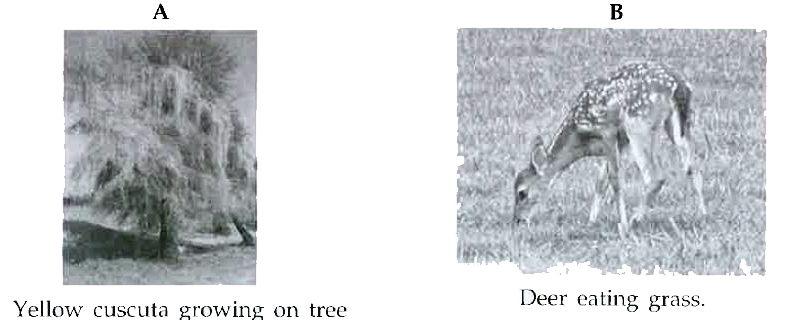Study the diagrams A and B. Answer the questions that follow : (a) Identify the type of nutrition given in the figures A and B.
(b) What mode of nutrition is shown in Fig. A ? Give another similar example from animal kingdom.
(c) What mode of nutrition is shown in Fig. B ? State a reason why a deer will have a larger small intestine than the tiger.
(d) From the above figures, find out an exception . Why is it so ?

Text Solution
(a)The given figures depict heterotrophic mode of nutrition.
(b) Fig. A show parasitic mode of nutrition. From animal world, leech, tapeworm, roundworm, ticks etc., are some of the organisms exhibiting this mode.
(c) Fig. B shows holozoic mode of nutrition.
Tiger being a carniore, feeds upon animal flesh which is mainly proteins and easier to digest, compared to which being herbivores feeds upon plant material. Plants material being cellulose is difficult to digest. Hence, tiger has smaller small intestine compared with that of a deer.
(d) Cuscuta is an exception. This is because, even though it is an angiosperm, it is non-photosynthetic and parasitic.
|
Topper's Solved these Questions
- LIFE PROCESSESBOOK - U-LIKE SERIESCHAPTER - LIFE PROCESSESEXERCISE - Short answer questions
39 Videos
- HOW DO ORGANISMS REPRODUCE ?BOOK - U-LIKE SERIESCHAPTER - HOW DO ORGANISMS REPRODUCE ?EXERCISE - LONG ANSWER QUESTIONS
47 Videos
- OUR ENVIRONMENTBOOK - U-LIKE SERIESCHAPTER - OUR ENVIRONMENTEXERCISE - SHORT ANSWER QUESTIONS
34 Videos
Similar Questions
Knowledge Check
What is the mode of nutrition in fungi ?
AparasiticBholozoicCsaprophiticDautotrophicThe mode of nutrition in bacteria is
AautotrophicBheterotrophicCautotrophic and heterotrophicDnone of theseWhat is the mode of nutrition of mushroom?
APhotosyntheticBChemosyntheticCParasiticDSaprophytic
